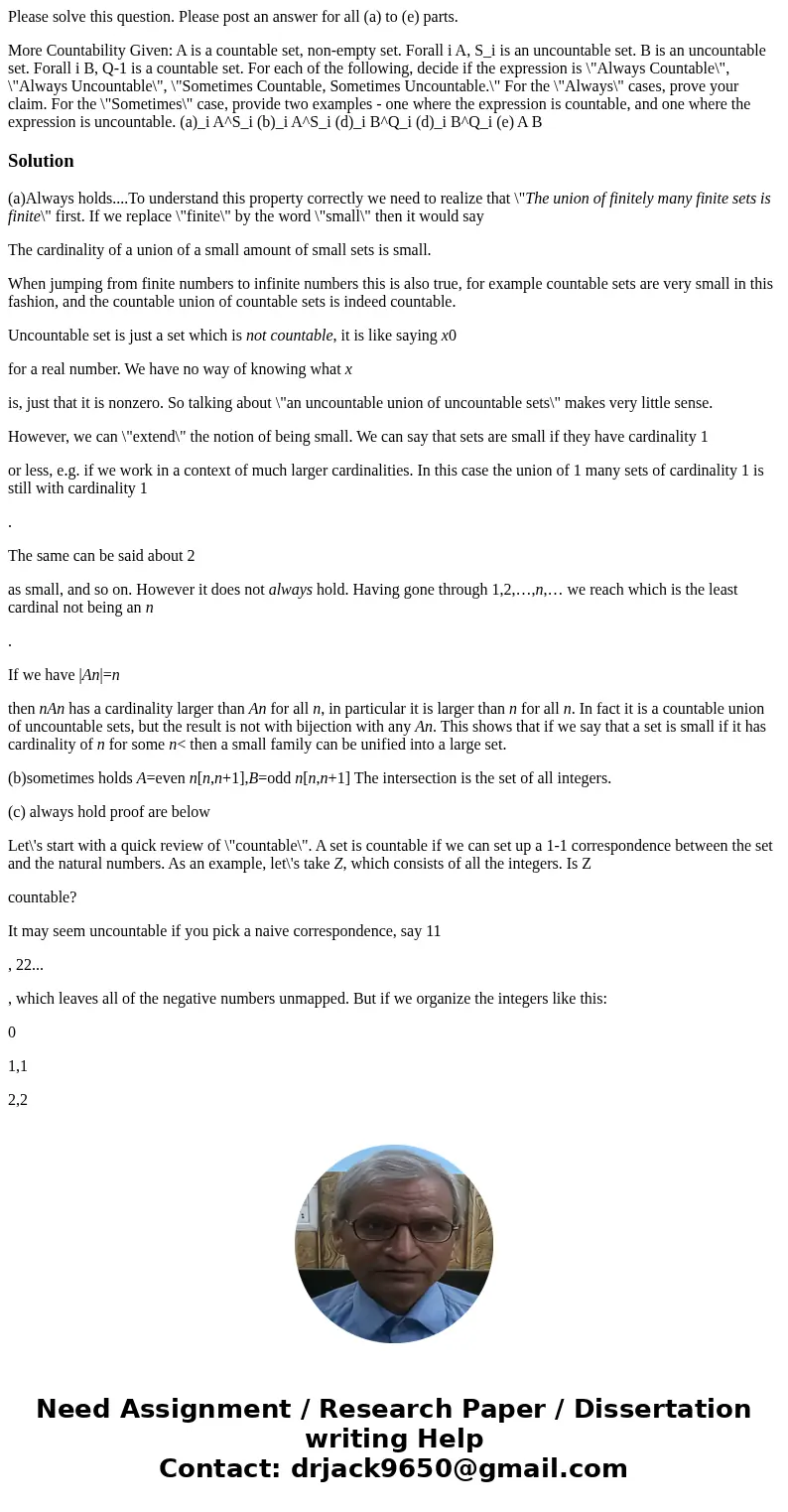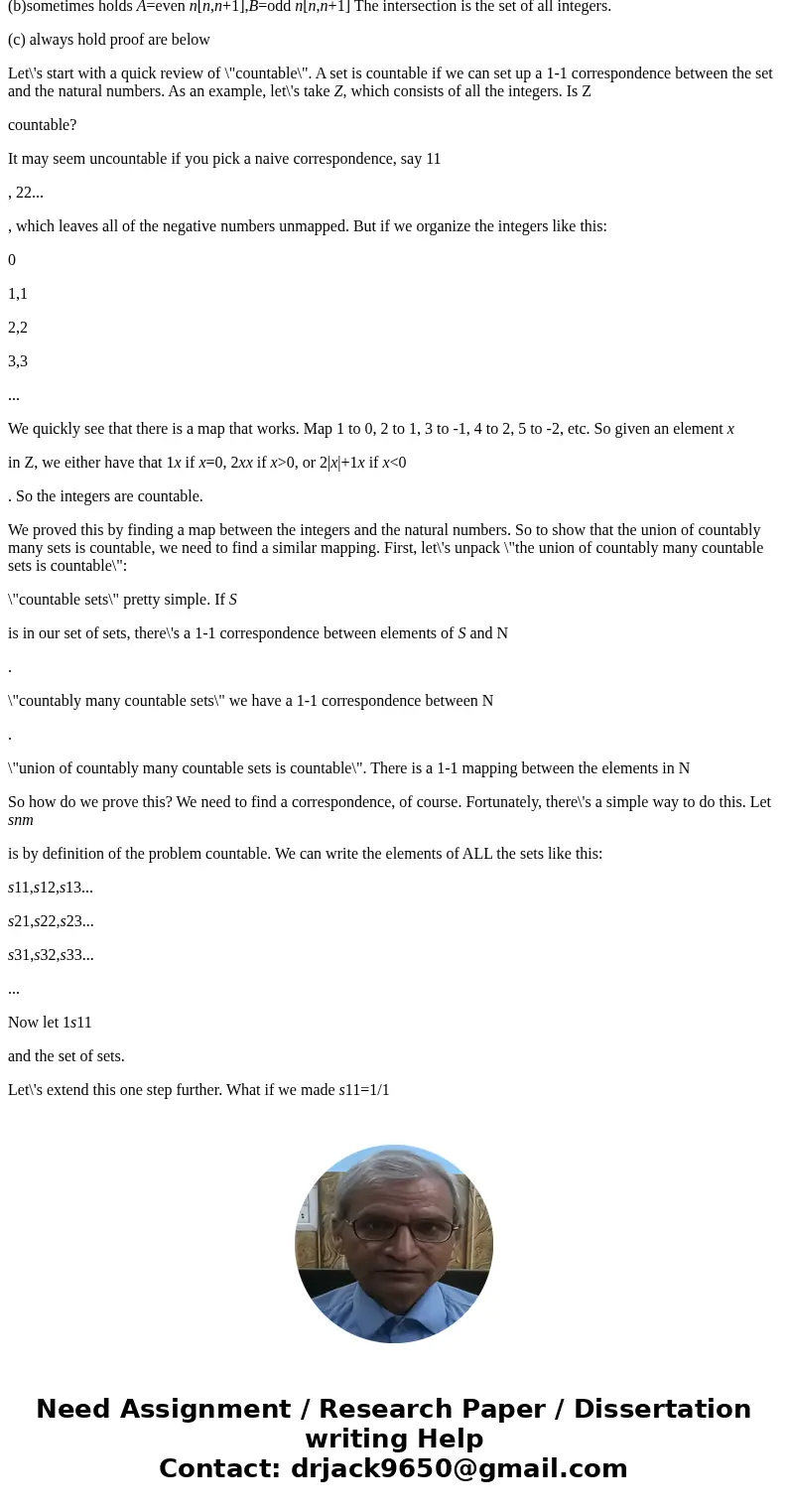Please solve this question Please post an answer for all a t
Please solve this question. Please post an answer for all (a) to (e) parts.
More Countability Given: A is a countable set, non-empty set. Forall i A, S_i is an uncountable set. B is an uncountable set. Forall i B, Q-1 is a countable set. For each of the following, decide if the expression is \"Always Countable\", \"Always Uncountable\", \"Sometimes Countable, Sometimes Uncountable.\" For the \"Always\" cases, prove your claim. For the \"Sometimes\" case, provide two examples - one where the expression is countable, and one where the expression is uncountable. (a)_i A^S_i (b)_i A^S_i (d)_i B^Q_i (d)_i B^Q_i (e) A BSolution
(a)Always holds....To understand this property correctly we need to realize that \"The union of finitely many finite sets is finite\" first. If we replace \"finite\" by the word \"small\" then it would say
The cardinality of a union of a small amount of small sets is small.
When jumping from finite numbers to infinite numbers this is also true, for example countable sets are very small in this fashion, and the countable union of countable sets is indeed countable.
Uncountable set is just a set which is not countable, it is like saying x0
for a real number. We have no way of knowing what x
is, just that it is nonzero. So talking about \"an uncountable union of uncountable sets\" makes very little sense.
However, we can \"extend\" the notion of being small. We can say that sets are small if they have cardinality 1
or less, e.g. if we work in a context of much larger cardinalities. In this case the union of 1 many sets of cardinality 1 is still with cardinality 1
.
The same can be said about 2
as small, and so on. However it does not always hold. Having gone through 1,2,…,n,… we reach which is the least cardinal not being an n
.
If we have |An|=n
then nAn has a cardinality larger than An for all n, in particular it is larger than n for all n. In fact it is a countable union of uncountable sets, but the result is not with bijection with any An. This shows that if we say that a set is small if it has cardinality of n for some n< then a small family can be unified into a large set.
(b)sometimes holds A=even n[n,n+1],B=odd n[n,n+1] The intersection is the set of all integers.
(c) always hold proof are below
Let\'s start with a quick review of \"countable\". A set is countable if we can set up a 1-1 correspondence between the set and the natural numbers. As an example, let\'s take Z, which consists of all the integers. Is Z
countable?
It may seem uncountable if you pick a naive correspondence, say 11
, 22...
, which leaves all of the negative numbers unmapped. But if we organize the integers like this:
0
1,1
2,2
3,3
...
We quickly see that there is a map that works. Map 1 to 0, 2 to 1, 3 to -1, 4 to 2, 5 to -2, etc. So given an element x
in Z, we either have that 1x if x=0, 2xx if x>0, or 2|x|+1x if x<0
. So the integers are countable.
We proved this by finding a map between the integers and the natural numbers. So to show that the union of countably many sets is countable, we need to find a similar mapping. First, let\'s unpack \"the union of countably many countable sets is countable\":
\"countable sets\" pretty simple. If S
is in our set of sets, there\'s a 1-1 correspondence between elements of S and N
.
\"countably many countable sets\" we have a 1-1 correspondence between N
.
\"union of countably many countable sets is countable\". There is a 1-1 mapping between the elements in N
So how do we prove this? We need to find a correspondence, of course. Fortunately, there\'s a simple way to do this. Let snm
is by definition of the problem countable. We can write the elements of ALL the sets like this:
s11,s12,s13...
s21,s22,s23...
s31,s32,s33...
...
Now let 1s11
and the set of sets.
Let\'s extend this one step further. What if we made s11=1/1


 Homework Sourse
Homework Sourse